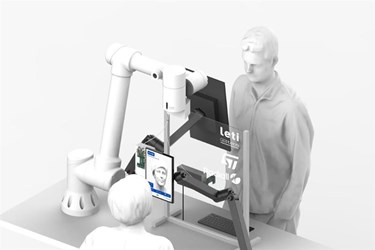CEA-Leti introduces plastic mmWave system

CEA-Leti has developed a hybrid, ultra-fast, ultra-low latency technology that is able to guide mmWave radio signals through flexible plastic tubing.
The system, called H-Link, is both low-cost and energy-saving and ensures Gb/s broadband connectivity that is able to overcome the limits of copper wire and optical fibre, such as oxidation of metal and brittleness. In addition to being flexible and less sensitive to vibration and electromagnetism, H-Link’s wireless technology delivers transmission speeds of up to 15 Gb/s.
Designed for multiple robotic and other applications, the system meets next-generation wireless-system performance requirements of the automotive, aeronautics, telecom, Industry 4.0 and healthcare sectors. The technology can transfer information over distances up to 10 meters at a speed of 15 Gb/s, with an average data transmission speed of 6 Gb/s over a little more than two meters.
mmWave systems operate in frequency ranges from 30 to 300 GHz and CEA-Leti’s previous work in mmWave communications has included the design and use of 5G networks on the MINATEC campus in Grenoble. mmWave technology will be required for future innovative services such as fixed, super-high-speed broadband access, industrial automation, healthcare and intelligent transport systems.
The plastic-based system, which is much lighter than copper, uses one-tenth of the energy of copper and less than fibre-optic cable. In addition, it can be connected by hand with tape, because it uses milli-meter waves rather than nanometer waves (optical fibre) and eliminates the need for heat splicing or welding.
H-Link advantages by application:
- Automotive: 100 percent wireless system delivers strong 360° signal and ultra-low energy consumption, which is essential in moving vehicles and that require multiple high-speed connections; not affected by vibration.
- Aeronautics/space applications: ultra-low power consumption is essential because of limited power supply; low weight is suitable for space missions.
- Telemedicine: robotics allows remote treatment, e.g., dentists working with patients in a clinic from a distant office; no cable kinking.
- Lab research: manipulation of robotic arms in enclosed containers, e.g., glove boxes, protects researchers from dangerous materials and eliminates electromagnetic interference that could affect findings.
- Industry 4.0, no cable kinking, no electromagnetic interference.
- Telecommunications: Reduces cost, power consumption and need for physical/cable links to meet data deluge in data centers. For 5G, need to transfer info from base station to emitting antenna at ultra-low cost.
“H-Link is a highly versatile and adaptable robotic system for multiple applications that use high-data-rate communication for performing scientific, industrial and medical tasks,” commented Didier Belot, an RF and mmWave design senior expert at CEA-Leti. “For example, in addition to allowing scientists to perform chemistry experiments or jobs in confined spaces and protected biology work with viruses and bacteria in gloveboxes, the system allows remote micro- and nanotechnology development and remote nuclear material manipulation.”